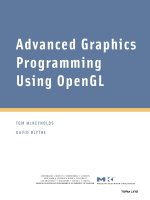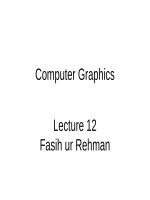Lecture computer graphics and virtual reality slides lesson 10 illuminiation and shading
Bạn đang xem bản rút gọn của tài liệu. Xem và tải ngay bản đầy đủ của tài liệu tại đây (1.59 MB, 52 trang )
Lesson 10
Illuminiation and
shading
Content
1. Overview
2. Illumination
3. Shading
1.
Overview
How lights can be seen?
■ The eye works like a camera
■ Lots of photo sensors at the back of the eye
■ Sensing the amount of light coming from
different directions
■ Similar to CMOS and CCDs
Information will be sent
to brain for processing
What colour is this
dress?
Object’s colour
■ What Affects the Color of a Point on the
Object?
□ position of the sample point
□ position of the light
□ color and intensity of the light
□ camera vector
□ normal vector of the surface at the vertex
□ physical characteristics of the object
(reflectance model, color)
Colour’s illusion
Lighting and shading
■ Lighting
□ How to compute the color of objects according to
the position of the light, normal vector and camera
position
■ Shading
□ Different methods to compute the color of the
entire surface
2.
Lighting
Factors affecting lighting
Light source
Surface properties
Light source
■ Light’s properties
□ Spectrum of light source (i.e. light colour)
□ Geometry properties
▫ Position
▫ Direction
▫ Shape
□ Decline in intensity
Surface properties
■ Surface properties
□ Spectrum (i.e. surface’s colour)
□ Geometry properties
▫ Position
▫ Direction
▫ Microscope structure
Lighting
■ Assuming we have a polygon and a point of view
in 3D space, we can specify a pixel correspondingly.
■ The task in lighting is that we have to specify the
colour of that pixel
■ If we want to make the scene look *right*, we
have to simulate the lighting process on the surfaces
inside the scene
Lighting models
■ Two types of lighting models
□ Empirical: Use simple formulas to create similar
observable result
□ Physics simulation: The lighting formulas will be
based on physics formulas in lighting
■ In most cases, experimental models will be used
in interactive computer graphics applications.
■ In modern computer graphics applications,
some physic simulation models have been more
frequently used.
Phong lighting model
■ By Bui Tuong Phong (Utah University) is a
lighting model which is a combination of both
experimental and physics simulation
■ Is the sum of 3 illumination terms
□ Ambient : 'background' illumination
□ Diffuse : non-shiny illumination and shadows
□ Specular : bright, shiny reflections
Ambient light
Ambient light
■ Light from the environment
■ Light reflected or scattered from other objects
■ Coming uniformly from all directions and then
reflected equally to all directions
■ A precise simulation of such effects requires a
lot of computation
➢Use a simple “trick” called ambient light
Ambient light
■ Simple approximation to complex 'real-world‘
process
➢Result: globally uniform color for object
Ambient light
■ For each lighting process, the ambient light
reflected from object surface only depends on
□ Surface’s properties
□ Intensity of the ambient light source (is a constant
with every point on object surface)
E.g. a sphere
Ambient light
I = ka Ia
□ I = resulting intensity
□ Ia = light intensity
□ ka = reflectance
E.g. a sphere

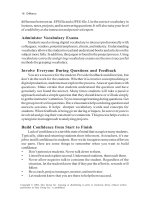
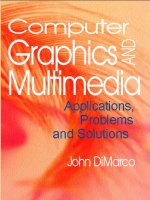


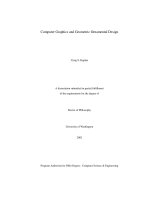
![mathematical foundations of scientific visualization, computer graphics, and massive data exploration [electronic resource]](https://media.store123doc.com/images/document/14/y/up/medium_upb1401358803.jpg)
